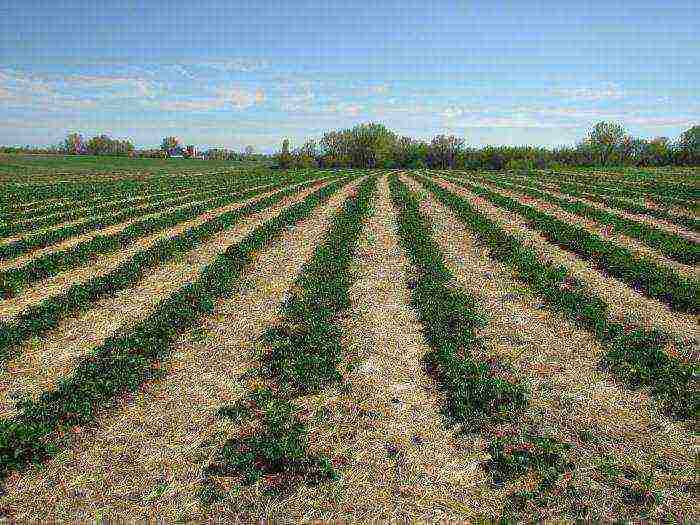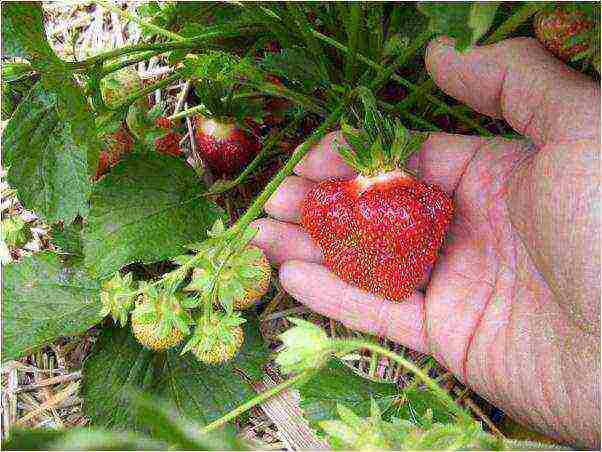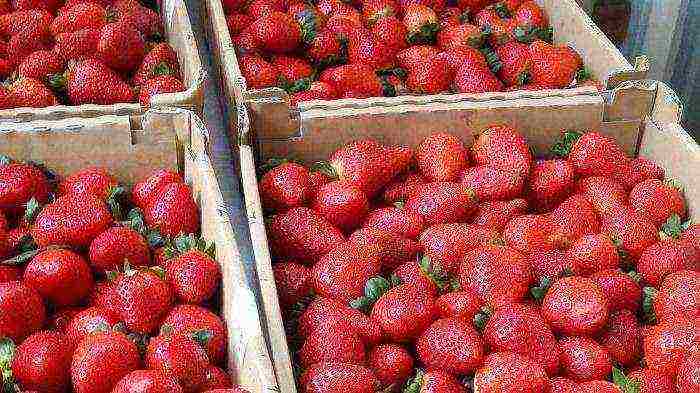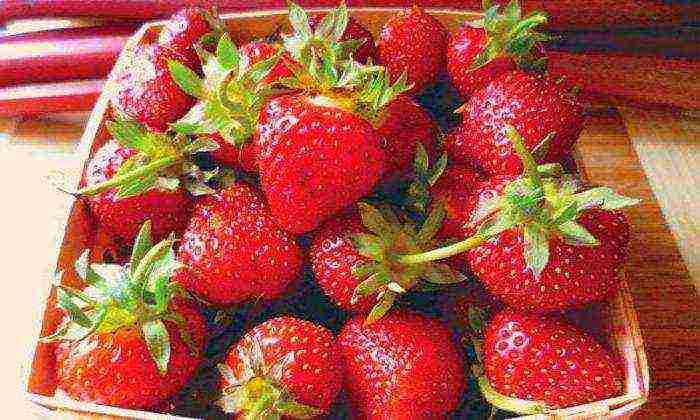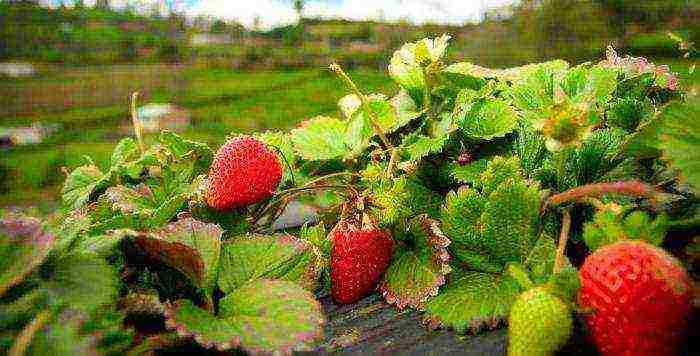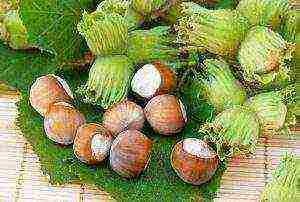Content
Harvesting of strawberries has begun in the Moscow region. Every day, 10 tons of berries are sent to shops and markets. The collection process is very painstaking and takes place without the participation of technology. Therefore, the state farms, more than ever, need working hands. As a reward, the assistants are promised a part of the harvested berries. And besides, agronomists willingly share their knowledge. How is strawberry different from strawberry and how to choose the sweetest berry?
Polka, Honey, Zingo, Zingano - such incomprehensible words mean such a familiar and beloved taste from childhood. There are dozens of strawberry varieties. On the Lenin State Farm, only four varieties are grown - only the sweetest ones, which do not need sugar. And despite the fact that in stores packaging with fresh and red berries beckon the buyer even in January, one can not be disappointed in the taste only for one month a year.
“An inexperienced person can buy varieties that are processed for freezing. She also has other taste qualities. They are not intended for fresh consumption. Although they sell everything in our market, ”explains Alexander Abramchuk, head of the gardening shop at the Lenin State Farm EZAO.
The collection of berries, which the average man calls strawberries, has just begun in the Moscow region. And few people know that in fact practically no one grows or sells strawberries. They are with strawberries, like sisters - twins. Only the strawberry ripens above the leaf, the strawberry hides under it. Ripening, heavy with aromatic juice, it sinks to the ground. Hence the name.
“People say everything - strawberries, strawberries. We stopped arguing. We even write on the price tags - "strawberry", and below - "strawberry". But the correct agronomic name is “garden strawberry,” says Pavel Grudinin, director of the Lenin State Farm ZAO.
Culture is whimsical. Dies from frost, rots from excessive rains. Requires weeding and constant maintenance. And collecting it is not an easy job, but very tasty.
“You look at one berry, as in fairy tales, put one in the box, the next in your mouth, and look at the other. And you look, the bed is long, and then you look, it seems that they have collected everything, "says Nadezhda Berdyukova, assistant to the foreman of the State Farm named after Lenin.
Strawberries are the only berry whose harvesting cannot be mechanized in any way. You can pick a ripe delicacy from the same bush every three days for a month. Because in one family of berries, as a rule, there is a ripe fruit, and so far only a flower.
“Unfortunately, we have not yet come up with devices that have determined by color whether the berry is ripe or not. This can only be done by a person who has visually looked at the ripe berry or not, ”continues Pavel Grudinin, director of CJSC Lenin State Farm.
To date, several tons of strawberries leave the plantations of the Lenin state farm to the table of the inhabitants of the region. In a week, the tons will be in the tens. There are no problems with the implementation, but with employees they can arise. Therefore, everyone is invited to the state farm to harvest. Even families. Nobody counts the berries eaten during work.
A few more days and all these berries will be sweet, but anyone can pick them. On very sweet and tasty conditions - every tenth box - home.
Irina Gorbunova
"Vesti Moscow" "from 20.06.2011
Garden strawberries are the most popular and useful of berries, they are consumed not only fresh, but also processed: in the form of juices, jams, preserves. The season for the mass harvesting and sale of strawberries is short and is only a few weeks.Berries grown not in greenhouse conditions, but in the open field are especially appreciated: a berry, caressed by the sun and grown in natural conditions, accumulates the maximum amount of useful microelements, therefore it is most useful.
In the open field, domestic strawberries are grown in many private farms, mainly in the south of our country. The largest domestic strawberry producer is CJSC Lenin State Farm (address: Leninsky District, Moscow Region).
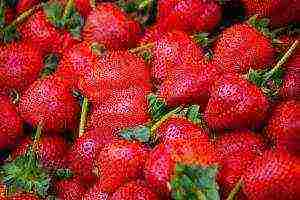
Modern agricultural complex
The combination of the words "Moscow, Lenin State Farm, Strawberry" became a live advertisement for a modern agricultural complex. The system of its activities includes several areas:
- Growing and selling organic berries (strawberries, raspberries, black chokeberries, gooseberries), potatoes and other high quality vegetables.
- Sale of strawberry seedlings.
- Breeding and sale of seedlings of zoned trees and shrubs for ornamental and fruit and berry gardening.
- Production of certified juices and juice-containing products (nectars and uzvars) from our own harvest. Their production is carried out on modern equipment according to old technologies, without the addition of preservatives. The products manufactured at the state farm have been repeatedly recognized as the best at various competitions and exhibitions.
Where is the state farm named after Lenin
In various regions and districts of our country, there are many agricultural and agro-industrial complexes, referred to in this way. The closed joint-stock company "Sovkhoz named after Lenin" is located on the lands of the rural settlement of the same name and is located in the Forest Park protective belt of Moscow.
The closed joint-stock company, which is in some way a monopolist in the cultivation of strawberries ("State Farm named after Lenin"), has the following address: Moscow, metro station "Domodedovskaya", then by buses No. 364 or 367 - to the state farm named after Lenin.
How strawberries are grown
Among all types of fruit products of the company, the first place is occupied by garden strawberries (strawberries). The Lenin State Farm gives over 110 hectares of land for berry plantation, and this makes it possible to collect up to 60 tons of berries daily during the ripening season.
The berry is grown in natural conditions without the use of fertilizers, therefore it has a rich and rich taste, it has a pronounced aroma, and has a special sweetness.
An important point: the state farm named after Lenin picks strawberries in a special way: each berry is picked by hand, carefully and carefully.
The shelf life of berries grown in natural conditions is rather short - no more than a day. To speed up the sale period (without losing the presentation), freshly picked berries are delivered to retail outlets in the Moscow region and Moscow no later than an hour after they are harvested.
Strawberry picking: 10% for picker
Every year, as soon as strawberries ripen in the fields, the Lenin state farm invites residents of the capital, its guests and everyone who lives in the Moscow region to take a personal part in picking berries. Payment for work in the field is carried out in the form of 10% of the harvested crop.
The conditions for participation in picking strawberries are very simple:
- Those wishing to work on strawberry plantations can come by a special free bus, which departs from the Domodedovskaya station early in the morning every day. The bus has the logo of an agricultural enterprise.
- In hot weather, you must definitely come in a headdress, in rainy weather - in rubber boots.
- During the day, lovers of delicious berries can not only harvest, trying to increase their 10% earnings, but also feast on environmentally friendly garden strawberries - during harvesting on the field, you can eat berries in unlimited quantities directly from the bush, without fear for your health, since no chemicals are used when growing strawberries.
- In the evening, you can also go back to Moscow on a free company bus.
Harvest time
Each year, the Lenin State Farm begins picking strawberries at different times. This is due to the fact that the ripening of the crop depends on both weather conditions and the variety of berries. Early strawberry varieties are to be harvested in June, late ones in July.
The management of the company notifies about the beginning of the season in advance, first indicating the approximate dates, and then the specific ones.
The harvest season usually lasts two or three weeks. On weekdays, up to 800 people come to the fields, on weekends - over a thousand. At the same time, the work is for everyone, since every year the production increases the volume of finished products.
All arrivals are met by the foreman, together with his assistants, he divides the arrivals into groups, conducts safety instructions, talks about how to pick strawberries.
The berry pickers are placed in the field, highlighting 1-2 beds, and an empty container is given out.
At the end of the work, everyone is given 10% of the harvested crop.
Where organic strawberries are sold
The state farm named after Lenin also exhibits its products at weekend trade fairs. The sale of strawberries grown in the fields of the state farm is carried out in special kiosks, the shape of which is unusual and does not go unnoticed. A huge strawberry is visible from a distance: the Lenin state farm remains faithful to this glorious berry, which is the basis for the logo of the famous complex.
Stationary strawberry-shaped stalls are located in different parts of Moscow and the Moscow region. They can be located near metro stations, on the central streets of Moscow and in the districts of the capital. However, the places of sale change annually - it depends on the decision of the metropolitan administration. Permanent places for trade in aromatic goods are: Moscow region, Leninsky district, the village of the state farm named after Lenin; Kashirskoe highway, 23rd kilometer, entrance to the Lenin state farm.
Before the start of the trading season, the specific addresses of the strawberry sales points of the Lenin State Farm are posted on the official website of the largest producer of ecologically clean, selected and fresh berries.
Sale of strawberry seedlings
The CJSC has its own Garden Center, where you can buy fruit and berry, as well as ornamental plants, zoned for the Moscow region. Agronomist consultants are ready to help in choosing, provide the necessary recommendations and answers to all questions regarding horticultural crops, from planting and watering to harvesting.
Just like in the fields, in the Garden Center, the beautiful strawberry again comes to the fore: the Lenin State Farm grows 15 varieties of garden strawberries and, accordingly, sells seedlings.
The main domestic varieties:
- Tsarskoye Selo.
- Sudarushka.
The most common foreign varieties:
- Honey.
- Zenga Zengana.
- Red Gonlet.
All of them differ in terms of ripening, berry shape and taste.
In the Garden Center, seedlings and seedlings are bought not only by residents of the capital - they also come for it from different cities and towns of the Moscow region.
Every year the Moscow Region State Farm im. Lenin "planting strawberries and strawberries of various varieties over nine dozen hectares of land, thus anyone can get to the berry harvest.
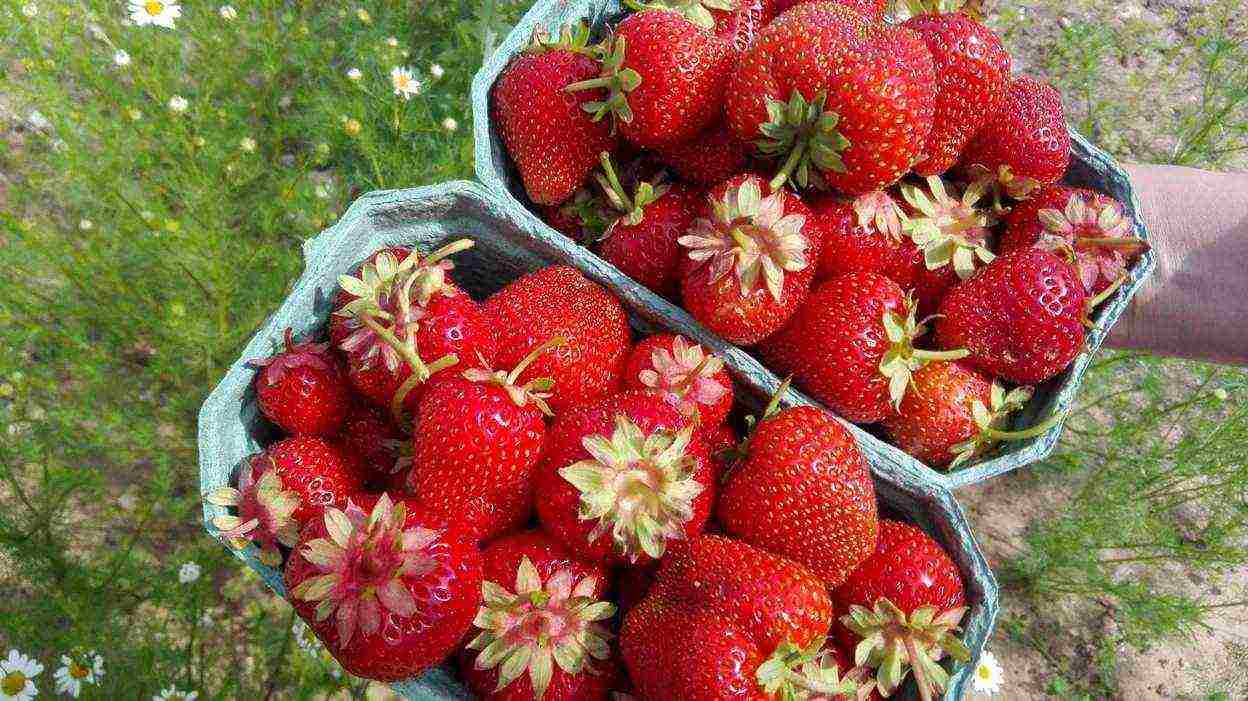
The state farm in a special garden center sells seedlings of berries wholesale and retail. Since the nursery is a monopolist in the cultivation of garden strawberries, the price will pleasantly surprise you. The main varieties for sale are Red Gauntlet, Zenga Zengana, Khonei, Sudarushka, Tsarskoselskaya, etc.
Basic collection rules.
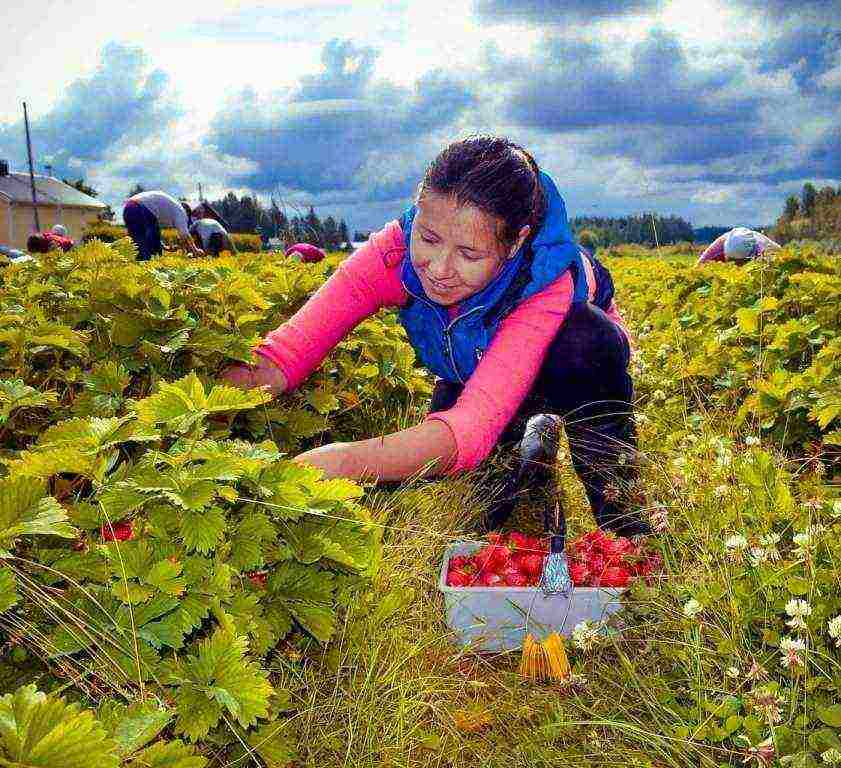
More than a thousand people come to the Moscow region annually to harvest the harvest. And this is not surprising! Strawberries are a healthy, tasty and quite expensive berry even in season.
Before starting work, they will conduct a detailed educational program with you, tell you how to collect correctly, which berry to take (necessarily with a stalk), and which one to dispose of. Public order in the fields is monitored by volunteers and foremen.
For picking you get paid with any assortment of berries in the amount of 10% of the total harvested weight, i.e.100 grams per kilogram. Many people come to collect for homework, and some just work hard, help the state farm and, oddly enough, have a rest. You can eat strawberries straight from the garden in unlimited quantities (the berries are clean, without chemicals) and this is a unique opportunity to try different varieties absolutely free. A working day on the field lasts somewhere between 13-14.00
If there is no desire to go, then the harvest of fresh berries can be bought in special stalls in the form of strawberries in Moscow, mainly in the south of Moscow near the metro stations "Domodedovskaya", "Orekhovo" and "Kantemirovskaya".
How to get there.
In Moscow, free buses run from the Domodedovskaya metro station according to the schedule, which can be viewed on the official website of the state farm. Departure time is from 6.00 am to 6.40 am. It is better to arrive in advance, as the queue is "live". You can come any day, when it is convenient for you, you do not have to sign up for all harvest days. Buses are taken away and brought back to the metro. You do not need to sign up in advance. You need to take water with you, have a snack and a container for the berries you earn (or purchase it from the state farm). Be sure to dress for the weather1 in the rain - rubber shoes, sun - a hat is required.
What sort of strawberries does the Lenin collective farm grow?
The variety is called Asia
Strawberries of the Asia variety are native to Italy. It was obtained by New Fruits breeders in Cesena. It happened more than 10 years ago in 2005.
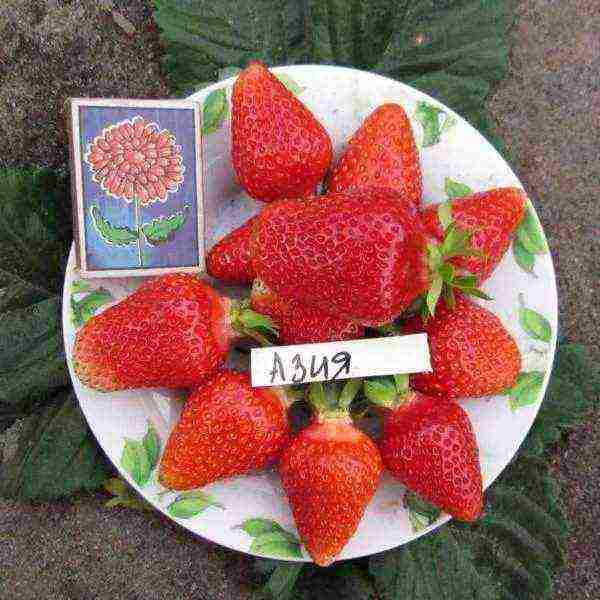
- Strawberry Asia is characterized by a powerful root system that can easily withstand the Russian frosts, therefore, although without shelter it can survive at -17 ° C, under a good snow cover it will quite withstand the harsh Siberian winters. If in your region winters are characterized by a small amount of snow, then strawberry bushes must be covered for the winter.
- For these purposes, you can use both non-woven material and a variety of organic matter: straw, coniferous spruce branches, fallen leaves.
- The bushes of this variety are large in size, medium leafiness, a little mustache is formed, but they are strong and thick. The leaves are quite large in size, slightly wrinkled, deep green in color. The shoots are thick, tall, and form a large number of peduncles.
- The strawberry variety Asia belongs to the medium-early in terms of ripening, that is, the first berries appear around the beginning of June, in the southern regions the beginning of fruiting may shift even to May. The fruiting period is quite extended - within a month.
- The variety can be called fruitful, especially when compared with conventional, non-remontant strawberry varieties. From one bush, you can get from one to one and a half kilograms of sweet berries.
- The description of the strawberry variety Asia will be incomplete without mentioning its shortcomings. Strawberry Asia shows moderate resistance to drought and various types of rot. It resists poorly to anthracnose and is poorly resistant to powdery mildew and chlorosis.
Description taken from the site
Berry picking in 2018.
At the moment, it is extremely difficult to predict the collection for 2018. By mid-June, you can call the administration of the state farm and clarify all your questions about dates, time and payment. Be sure to check about the age of the children (children under 14 years old are not allowed on the field), as well as whether there is a permit to come by your own transport. All information can be tracked on the official website of the state farm.
All presented varieties are available and in sufficient quantity.
The Albion variety was bred by American scientists relatively recently, in 2006. The main feature of this subspecies is the ability of continuous and long-term fruiting. Under favorable conditions and sufficient care, the crop can be harvested from late May to late September. For the entire season, 1 bush can produce up to 1-2 kilograms of berries. This variety is resistant to drought, but tolerates excessive heat and frost much worse. There is a high resistance to diseases such as gray rot and anthracosis. The berries have the correct heart-like shape. The surface of the strawberry is glossy, of an even red color. The seeds are large enough, yellow-green in color.The pulp has a pink tint. The Albion variety does not produce a large amount of tendril growth. From the moment of planting, the Albion strawberry requires careful maintenance. The most important thing is watering. This culture loves moisture. The productivity of the bushes and the juiciness of berries depend on this. It is especially necessary to carefully maintain a sufficient level of moisture in the first weeks after planting the seedlings. But it is also not recommended to create a swamp on the site, since then there is a risk of rotting of the stems and strawberries may grow tasteless. The Albion variety loves feeding. Within 1 month after planting, organic matter and complex mineral fertilizers can be applied under the bushes. Disease spraying is not necessary, since the variety is resistant to most diseases. Mulching is one of the important steps in caring for this strawberry variety. This procedure will help you retain moisture at the roots longer and eliminate the need to constantly loosen the soil. Mulching also prevents weeds from growing. Straw or sawdust can be used to process row spacings. Such organic material will not need to be harvested in the fall. It will be an excellent fertilizer for the next year.
Price
RUB 70
.
Aromas is an American neutral day strawberry. The Aromas variety begins to bear fruit at the end of May and fruiting continues until frost, sometimes until the berries are covered with snow. The variety is unpretentious to external conditions. Fruiting continues in hot weather. But the mass formation of mustaches begins after the temperature drops, somewhere in mid-August. Although, with sufficient moisture supply, whiskers form throughout the summer. The bush of the variety is high, erect. Peduncles are strong and set high. Often the berries are ripe and do not touch the ground. Aromas strawberry has a bright red, shiny cone-shaped berry. The berry is very attractive. The taste is sweet with a delicate strawberry aroma. The size of the berries is large and medium. The berries are resistant to mechanical damage and have high transportability. The Aromas variety is resistant to such serious diseases as powdery mildew and anthracnose. Tolerant to viruses. The great value of the Aromas variety lies in the fact that the variety also bears fruit well in the second half of summer and autumn, when the varieties of one-time fruiting no longer produce berries. Autumn berries ripen at least longer due to the lack of sufficient heat, but at the same time they have a very sweet taste. At the same time, since the density of the Aromas berry is high, the variety is excellent for freezing. In addition, you can freeze a berry harvested precisely at the end of summer or in autumn. This means that the berries will lie in the freezer before use for less time than berries frozen at the beginning of summer. By the way, the shelf life of frozen berries is up to six months, or even less. It depends on the freezing temperature. So, the less the berry is in the freezer, the more vitamins are stored in it.
Price
RUB 70
.
Dutch novelty among remontant varieties. Late. Begins to bear fruit in early July and may continue to yield until the first frost. If in the autumn period, before the onset of stable frosts, Vima-Rina is placed in film tunnel shelters, fruiting can be extended until November. Unlike most remontant varieties, Vima Rina berries have excellent taste. On a 5-point scale for tasting strawberry fruits, Vim Rina's taste is rarely below 4.8 points. For comparison, the same qualities in the extremely popular among amateur gardeners "Queen Elizabeth" are estimated by experts by tasters at 3.7-4.2 points. The vast majority of remontant strawberry varieties do not please gardeners with the size of the berry. Vima Rina is a rare exception and is second only to Queen Elizabeth in this indicator, standing on a par with Russian Size. The berries are intensely red, cone-shaped, graceful in shape, reaching 50 g.The delicate texture of the pulp makes the berries of this variety an exquisite dessert. At the same time, the fruits also have good transportability. Possesses reliable winter hardiness, complex resistance to the main diseases of garden strawberry. The adaptive ability is extremely weak. Perhaps, today it is one of the best varieties of remontant strawberries.
Price
RUB 70
.
It is a neutral-day remontant variety, the remarkable qualities of which can be expressed in one epithet "Samy": - this is the most famous remontant variety in Russia today. As an elite seedling, it was brought to our country from Great Britain back in the 80s of the last century and was first known as Queen Elizabeth. Later, breeder M.V. Kachalkin bred from it the most large-fruited and productive clone, which received the present name of Queen Elizabeth II; Is the earliest strawberry variety. So in the favorable year 2002 without film shelters, the first berries ripened at the end of May, before honeysuckle! And at the beginning of June there was a mass gathering, i.e. Elizabeth II was two weeks ahead of the earliest common strawberry varieties. Overall, this variety produces two distinct harvest waves. The first in early June, the second, more weighty and with the largest berries - from the second half of July; - this is the most productive variety not only among remontant, but also among ordinary strawberries. According to long-term observations, the average yield for two harvests is 4 kg / m2. In favorable weather years, the productivity of this variety is phenomenal. According to the author of this variety M.V. Kachalkin in 2002 on the plot of the experimental selection nursery, the total yield per plant was 1.7 kg with a density of 6 plants per m2, i.e. the yield from 1 m2 has reached 10.2 kg - and this is in the suburbs! Such results are comparable with the indicators of industrial plantations of strawberries, such leaders as Israel, USA, Spain; - This is the largest remontant variety. A record of an experimental breeding nursery, some berries reached 100-110 g. There are data from the gardeners of the South Urals - 90 g. Most of the berries weighing 40-50 g. The berries are spectacular, bright red, dense, transportable, excellent for freezing; - This is the most winter-hardy remontant variety. Despite its British origin, it perfectly "holds" Central Russian winters. In addition, the variety is resistant to most fungal diseases. And one more advantage. Elizabeth II is great for vertical culture. From this variety, you can create spectacular compositions in pots, on trellises. By the second half of July - early August, all the rosettes of the mustache are blooming and berries are tied. M.V. Kachalkin received 2.2 kg of berries from each 10 l container in which 3-4 plants were planted and formed vertically. Nice and productive!
Price
RUB 70
.
Super novelty from the wonderful breeder Aitzhanova S.D. The parents of "Lyubava" were two outstanding varieties: one of the best remontant varieties of foreign selection "Geneva" and a variety of Russian selection, the author of which is also Svetlana Dmitrievna Aitzhanova - "Solovushka". Lyubava can rightfully be called the best remontant strawberry variety of domestic selection. In terms of winter hardiness, it surpasses all foreign varieties of a similar type. Berries "Lyubava" weighing up to 25 g, cone-shaped, aligned, dark cherry color, with a glossy surface, dessert, excellent taste with a delicate aroma of wild strawberries. The aroma is inherent in berries, both in the spring - summer wave of fruiting, and in the summer - autumn. The berries of the second wave of fruiting (on the mother plant and on the rosettes of the mustache) ripen earlier in Lyubava than on other remontant varieties - in mid-July - early August. Continuous fruiting lasts 2-3 months and ends only after the onset of severe frosts. During this time, the bush forms a yield of up to 1.5 kg. A characteristic feature of the variety is the amicable ripening of berries and good preservation on the plant.This allows harvesting once every 7-10 days, while up to 20 excellent quality berries can be harvested from one bush. The fruits can be stored for a long time without a refrigerator and can withstand transportation, because their flesh is very dense. Berries "Lyubava" can be considered one of the best for freezing. Unlike berries of other varieties, after defrosting, they not only do not lose their taste, but even improve them, acquiring a unique aroma and taste, while maintaining the consistency and density of fresh berries. "Lyubava" has increased resistance to major diseases and pests: powdery mildew, brown leaf spot, gray fruit rot, transparent strawberry mite. These qualities allow amateur gardeners to almost completely abandon chemical treatments and ultimately get the most environmentally friendly harvest. "Lyubava" is extremely decorative. Its bushes are medium-sized, the leaves are dark green, clean from spots, glossy. And most importantly - the flowering of the second wave of fruiting. It is abundant, snow-white flowers, both on mother bushes and on rosettes of a few mustaches (5-7 pieces of them per bush) are 1.5-2 times larger than those of similar remontant varieties, reaching 35 mm in diameter. The mustache, without even having time to take root and form a normal leaf apparatus, throw out powerful inflorescences, bloom profusely and bear fruit. In this regard, it is very interesting for vertical cultivation culture. Therefore, the smallest bed of Lyubava in a summer cottage makes an unforgettable impression, even on experienced, seasoned gardeners. "Lyubava" is an intensive variety. Abundant flowering and fruiting quickly "wear out" the mother plant, therefore experts recommend using plants for no more than 2 years, renewing (rejuvenating) berry plots by planting mustache rosettes from the same mother bushes.
Price
RUB 70
.
Origin: Surprise Olympiad x Festival daisy. Originator: Kokinsky strong point VSTISP, Russia. A late ripening variety, highly winter-resistant, high-yielding (11.0-12.0 t / ha), slightly affected by white and brown spots, relatively resistant to gray rot. The bush is vigorous, medium spreading, well leafy. The assimilative ability is average. The berries are red, large (average weight 25-35 g), shiny, oval-conical, dense, juicy, sweet and sour taste, with aroma. The transportability of the berries is high. Suitable as a dessert and for technical processing. To realize the potential productivity of the proposed varieties, it is necessary to strictly observe the basic requirements for crop cultivation.
Price
RUB 70
.
At first glance, a nondescript folk modest has exceptionally pleasant-tasting berries. A variety of unknown origin, apparently of folk selection, which came to us from Western Europe under the name Pineapple White. It has been widely cultivated on the territory of Russia since the 20s of the last century. "Veteranka" has a powerful medium-leafy bush, medium ripening. On thick, high peduncles, medium-sized (15-18 g) berries are tied, blunt-conical in shape from pale red to light pink in color. The pulp is white, friable, with a large cavity inside. What's good? Unique berries: they are very delicate, melt in the mouth, harmonious sweet-sour taste with a strong pronounced pineapple-strawberry aroma. Therefore, the fruits of this variety are used as an exquisite dessert on the principle of plucked and eaten. Pineapple berries are very loved by children.
Price
RUB 70
.
Late ripening, unrepairable, canteen. The bush is medium, semi-spreading, densely leafy. The mustache is medium, pale red and abundant. Leaves are medium, light green, medium wrinkled, slightly ribbed, concave, pubescent, shiny. The leaf teeth are obtuse, wide.The shape of the middle lobe of the leaf is obovate. The stalks are medium. Berries with an average weight of 30 g, maximum - 40 g, regular blunt-conical shape, no neck, orange-red, shiny. They contain: sugar 5.7%, acid 0.8%, vitamin C 79 mg%. The taste of berries is sweet and sour with aroma. The pulp is red, juicy, dense, the tasting score of fresh berries is 4.5 points. Drought resistance and heat resistance are high, winter resistance is good. Resistance to diseases and pests is high, higher than standard varieties.
Price
RUB 70
.
Ultra-early Dutch variety obtained from crossing the most popular in Europe Elsanta x Corona. Begins to bear fruit, depending on weather conditions, in late May - early June. The berries of the first harvest reach 35-42 g, alo-red with a yellow tip, truncated-conical shape, sweet, juicy, of exceptional taste with a pronounced aroma. Berries are suitable for exclusive decorations (cakes, pies, desserts). Excellent transportability due to the high density of the fruit. They can be stored without a refrigerator for several days. The average yield per bush is 600-800 g. The variety is very unpretentious, has a high winter hardiness and complex resistance to verticillary wilt and powdery mildew. In terms of a complex of valuable traits, this variety is ideal not only for amateur gardening, but is also of particular interest for commercial production of berries.
Price
RUB 70
.
This variety was invented by crossing two well-known strawberry varieties: "Festival Chamomile" and "Surprise Olympics". Medium early ripening. The bush is semicircular, slightly spreading. Short but powerful. The foliage is slightly concave and moderately bubbly. A small amount of mustache. Inflorescences are medium, located just above the leaves. The flowers are relatively small, the inner calyx in which is larger than the outer one. The fruits are oval-conical, red in color. The pulp of a ripe berry is juicy and dense. The taste of the berry is sweet with a slight sourness. Large berries - from 30 to 40 grams. The variety gives consistently high yields: up to 1.3 kg of berries can be harvested from 1 square meter. Shows resistance to mites and gray rot, weakly affected by brown and white leaf spot. Winter hardy high.
Price
RUB 70
.
The variety is Dutch, with a long-standing (1968) Russian residence permit. Medium-late ripening. World record holder for large-fruited, officially included in the Guinness Book of Records. Individual berries reach 9cm in diameter and 120g "live weight" (medium apple)! The most real indicators are 85-105 g. Small berries do not exist at all. The average weight of the main collection berries is 40-60 g. As a rule, large-fruited strawberry varieties do not differ in their exquisite fruit taste. The Dutch gulliver is a pleasant exception. Berries of exceptionally high quality, dense, transportable, can be stored in the refrigerator for up to 7 days. They freeze perfectly, do not become limp when thawed, if plucked from the stalk. Peduncles up to 10 mm thick hold well even such heavy berries that do not touch the ground and are not damaged by gray rot. A long-lived variety, bears fruit without reducing the yield and quality of berries for 8 years! (common strawberry varieties - 4 years). This variety is distinguished by huge beautiful burdock leaves, whiskers 6-7 mm thick, flower stalks as thick as a cigarette, the diameter of a two-year-old bush is 60 cm. This is not a commercial market variety, but a collection one, for the soul! Not "cabbage", but "rose", a worthy decoration of the site. With good care from an amateur gardener, you can get a yield of up to 1.8 kg per bush, and with the "Dutch diet" (abundant, balanced feeding and timely watering) up to 2.8 kg of berries from one bush.
Price
RUB 70
.
What kind of beast is this, a dugout? This is an interspecific hybrid of large-fruited garden strawberries (Fragaria ananassa), which amateur gardeners in everyday life incorrectly call strawberries and real European strawberries or nutmeg strawberries (Fragaria moschata). For the first time these wonderful berry hybrids were obtained by the scientist-breeder T. Kantor at the All-Russian Institute of Selection and Technology of Horticulture and Nursery (VSTISP)."Muscat Biryulevskaya" is her own brainchild, combines the best properties of its parents: large-fruited - from garden strawberries, and winter hardiness, unique aroma and taste - from strawberries. The bush is tall, powerful, densely knotted with dark green beautiful leaves, with deep textured veins. Thick, straight, not lodging, even under the weight of the berries, flower stalks rise above the bush and can carry a "cloud" of 250 white flowers and the plant as a whole looks very impressive. Berries set up to 100%. They are dark red, burgundy-purple when fully ripe. Berries of the first harvest up to 25 g, on average 8-10 g. Productivity up to 300 g per bush. The berries are dense, transportable, practically not affected by gray rot. The pulp is dark red, sweet, with a strong spicy nutmeg aroma inherited from strawberries. When processed, they give a fragrant, amazingly beautiful dark syrup, do not boil down into jam, retaining their original shape and color. With a delay in picking, the berries do not crumble or rot. They wither in the free breeze and sun directly on the peduncles, turning into a kind of raisins, very beloved by children. Having prepared such "raisins" for future use, you can brew it into tea. Believe me, seagulls with a dugout in winter bad weather is a fairy tale.
Price
RUB 70
.
What kind of "beast" is such a dugout? This is an interspecific hybrid of large-fruited garden strawberries (Fragaria ananassa), which amateur gardeners in everyday life incorrectly call strawberries, and real European strawberries or nutmeg strawberries (Fragaria moschata). For the first time, these wonderful berry hybrids were obtained by the scientist - breeder T. Kantor at the All-Russian Institute of Selection and Technology of Horticulture and Nursery (VSTISP). Merchant's wife is the newest variety created by the remarkable breeder S.D. Aytjanova (Kokinsky stronghold of VSTISP). Svetlana Dmitrievna is the author of a whole series of varieties of the 2nd generation dugout. The merchant's wife is one of the best among them and is devoid of such shortcomings of the first generation varieties as low yield, small fruit, excessive "mustache", clogging up the site. The merchant's wife has absorbed the best qualities inherent in this interspecific hybrid: 1. Amazing, peculiar spicy-nutmeg aroma, sweet, with a slight harmonious acidity taste of berries, which none of the varieties of garden strawberries possesses. The berries themselves are aesthetic, elongated-oblong, 6-7 cm long, of an attractive ruby-burgundy color with a purple "tan", reaching a weight of 25 g (on average 8-15 g). The yield reaches 300 g per bush, which can bear up to 15 peduncles with 200 berries. Outstanding performance for this crop. 2. Very high winter hardiness, undemanding care, complex immunity to many diseases inherent in large-fruited garden strawberry, due to which it pleases gardeners with harvest even in critical wintering and vegetation conditions (rainy, "rotten") years. 3. With a delay in picking, the berries do not crumble, do not sour and do not rot, because. have a dense consistency (have excellent transportability). They wither in the free breeze and sun directly on the peduncles, turning into a kind of raisins. The kids are crazy about this dried fruit. Among all varieties of strawberries, it is the Merchant's wife that the children choose as their favorites. Having prepared the earthworm "raisins" for future use, you can brew it in tea. Believe me, tea with a merchant's wife in winter bad weather is a fairy tale! Remembering summer will improve your emotional state, and a rich complex of biologically active substances and vitamins will strengthen your immunity. 4. Amazing quality processed products are obtained from the Merchant's berries, which have a dark red pulp and a magical aroma. The jam has a fragrant, beautiful dark syrup with uncooked berries that retain their original shape and color. 5. Finally, a unique property inherent in this particular variety is its high decorative effect. Powerful, tall, stately, very beautiful bush with dark green broad leaves.In the springtime, it bears on strong non-drooping peduncles many huge, dazzling snow-white flowers and is not inferior in beauty to a flower bed. IN TRUE - MIRACLE BERRY!
Price
RUB 70
.
Zenga Zengana is a variety developed in Germany. A variety of medium ripening, winter hardy. The bush is tall, compact, densely leafy. Peduncles reach the level of leaves, the inflorescence is compact, with long thin pedicels. The flowers are of medium size, bisexual. The berries are wedge-shaped or round-conical, often ribbed, dark red, shiny with achenes buried in the pulp 30-40 g. The pulp is dark cherry, sweet-sour, aromatic. The variety is high-yielding, resistant to brown spotting, suitable for technical processing. Little prone to late blight and verticillary wilt. It is rarely affected by a tick. Has a high adaptability to growing conditions. Add Zengu Zengan to your strawberry plantation and she's bound to become your idol!
Price
RUB 70
.
A very promising medium early Dutch variety. Bred by crossing Gorella and Chandler. Ripens on average a week later than Vima-Zanta. The berries are very large, individual up to 50 g, conical in shape, they resemble a heart; the amazing bright red color attracts the eye with its saturation (which indicates its healing properties, the scarlet-red color is an indicator of the amount (of flavonoids), and the "caramel" taste of aromatic berries will not leave anyone indifferent. The fruits of this variety are distinguished by a high content of natural sugars, up to 10%. A particularly valuable feature is its high resistance to sharp temperature fluctuations in winter. Given the nature of modern winters with their constant thaws, this property of Kimberly can be of decisive importance when choosing a variety. Resistant to the main diseases of garden strawberries, especially powdery mildew. " Caramel Heart "will take its rightful place in your garden and will be especially loved by your family and friends!
Price
RUB 70
.
Garden strawberry "Kokinskaya Zarya" is a very early, dessert variety of garden strawberries. The variety was bred at the Kokinskaya experimental station VSTISP as a result of crossing the garden strawberry Slavutich with selection 157-7. Under favorable weather conditions, fruiting begins in the first half of June. The garden strawberry variety "Kokinskaya Zarya" has a stable yield. A bright red berry with dense pulp, with a memorable taste and aroma! The variety is appreciated as very early and extremely tasty. Large berries 30 - 35g. Winter hardiness is very good. Strawberry bushes, with proper agricultural technology and preparation for winter, are not damaged by low temperatures. Seedlings of garden strawberries "Kokinskaya Zarya" are planted on raised ridges, with well-prepared soil. In the process of growth and fruiting, it is necessary to regularly feed and carry out preventive treatments against pests and diseases. The variety is resistant to fungal diseases of the leaves and damage by strawberry mites. Berries are versatile. Well suited for all types of homemade preparations, as well as for fresh consumption.
Price
RUB 70
.
This variety of British "blood" appeared on the Moscow market of amateur gardening in the mid-80s. Then there was a lot of talk about him. For the bush they paid a lot of money for those times. And now, 25 years later ... The Lord is practically forgotten. But in vain! The noble English "Lord" has a whole list of merits. It is of medium ripening and has a long yield period. In the conditions of the Moscow region from June 15 until July 30. With good care, the yield reaches 1.5 kg of berries from a bush. "Lord" has a stately figure. The habitus of the bush is powerful, tall, spreading.The diameter of a two-year-old bush reaches 60 cm, with a height of 50-60 cm, the leaves are large, light green. Very large berries are formed on powerful peduncles. Often, among experienced gardeners, berries in 80-110 g. Average weight - 25 g (fluctuations 20-45 g). Fruits are round-conical in shape, fragrant, sweet, bright red in color, dense, transportable, does not flow up to 3 days without a refrigerator. The variety is long-lived, which can be grown in one place for up to 10 years, a very rare property for most strawberry varieties. Moreover, the first 5 years "Lord" increases the yield by increasing the number of flower stalks. Despite its British origin, the variety is highly winter-hardy. For 12 years of observations, no cases of plant freezing in winter conditions in central Russia have been noted. What is especially valuable "Lord" has increased resistance to gray rot. This greatly reduces crop losses in abnormally humid years. All this, according to V.I.Kudryavtsa, an experienced gardener, a professional specialist, places "Lord" among the best and most reliable varieties for amateur gardening. Farmers, gardeners specializing in small-scale berry production, also highly rate "Lord" as one of the best "market" varieties, berries which are in high demand among buyers. One "but". Since the "Lord" variety is an intensive type - it forms a bountiful harvest for a long time, it requires abundant watering before the first berries ripen and three times a day feeding during the period of active growth and fruiting. Does not fatten from "overfeeding" with organic fertilizers (humus, compost, etc.).
Price
RUB 70
.
The Besseler variety of the 70s-80s of the last century and does not give up its positions in our time. Soviet "heavyweight" - our answer to the Dutch "gulliver" Gigantella Maxim. This remarkable variety of medium ripening was selected from hybrid seedlings (Komsomolskaya Pravda and Krasavitsa Zagorya) in the state farm near Moscow. Lenin under the leadership of the famous breeder N.K. Smolyaninova back in 1953. This strawberry variety got its second most popular name "Mashenka" in honor of the daughter of the then director of the state farm - Masha Ryabtseva. This variety is distinguished by the fact that if you remove some of the buds on the plant before the flowers open, you can get truly record-breaking berries weighing up to 150 g! Often 110 gram specimens, and on average 40-60 g. Fruits of pleasant, harmonious sweet-sour taste, aromatic, perfectly withstand long-term transportation. There is no one less demanding among the varieties of heavyweights than Mashenka. It is "in the Soviet way" unpretentious, "in the Siberian way" winter-hardy, does not require intensive farming to obtain significant harvests.
Price
RUB 70
.
This medium-late ripening variety was bred in Germany in the thirties of the last century. Differs in a unique nutmeg taste, reminiscent of both strawberries and raspberries at the same time! The garden strawberry variety Mice Schindler produces low bushes, with a small number of obliquely growing leaves. The size of the leaves is small, the upper surface is smooth, dark green, with a slight sheen. The lower part of the leaf is ribbed. During the first harvest, the weight of one berry can reach 10-20 grams, but usually its average weight is 5 grams. The shape of the berries is rounded, dark cherry color. The surface of the fruit is shiny, the color is uniform, bright red. The pulp is tender, sweet, excellent in taste, dense. Up to 0.8 kg of fresh fruit can be obtained from one square meter of plantations. According to the quality of the berries, it is considered one of the best dessert varieties; children will really like it. Perfectly adapts to soils, unpretentious to growing conditions, drought / frost-resistant and resistant to major diseases. Flowering is unisexual. Successful pollination requires planting late-maturing pollinating varieties next to Mice Schindler.
Price
RUB 70
.
Garden strawberry Rusich - medium late ripening. Spherical bush, medium density. Vigorous. The leaves are dark green, glossy. Little mustache. The berry is large, conical, slightly ridged, dark red, of medium density, with red pulp, with an average weight of 35 g. The taste of the berries is sweet and sour. Tasting score 4.5 points. The average yield is 104.6 c / ha. The variety is frost resistant. Disease resistance is average. Universal use. Soil: strawberries grow on any soil, but its yield is in direct proportion to the fertility of the soil. It grows best on light and medium-textured soils with an acidity of pH 5.0–6.5. When preparing the soil, 5–6 kg of organic fertilizers and up to 40 g / m² of mineral fertilizers are applied per 1 m². Then a deep digging of the site is carried out. They start planting after the prepared soil has settled.
Price
RUB 70
.
A charming guest from Scandinavia. Medium ripening Swedish variety with unique advantages. The bush itself stands out as a beautiful article: it is powerful, with juicy dark green sharp-toothed leaves on thick strong petioles. “Sarah” contains the wild strawberry genes that give it a Nordic hardy character. It is absolutely winter-hardy, disease-resistant, unpretentious in care. Strawberry "blood" gives the very attractive berries (shiny, dark red) a unique taste and aroma. When you eat the berry, there is a pleasant refreshing aftertaste in your mouth with a magnificent, pronounced aroma of wild strawberries. "Sara" is one of the best varieties for therapeutic and dietary nutrition, the berries of which contain a valuable complex of bioactive substances (BAS). The high content of vitamin B9 in combination with iron salts are indispensable in the treatment of anemia (anemia) and rheumatism! The high iodine content in Sara's berries has a beneficial effect on the functions of the thyroid gland. And, finally, the berries of this variety hold the record for the content of the rarest BAS-ellagic acid, the action of which is aimed at preventing cancer.
Price
RUB 70
.
Symphony - A selection of the Scottish Institute for Horticultural Research, medium late ripening with an extended harvest period. The bushes are well leafy, the leaf is very tough. The berries are large, conical in shape, bright red in color, with colored pulp, excellent taste. The berries are very fast and transportable. The variety is distinguished by high frost resistance, resistance to gray rot and verticillary wilt. Powdery mildew resistance is also quite high. Due to the extended ripening period, the variety is ideal for those who come to the country once a week. It is necessary to learn how to determine the full ripeness of a berry experimentally (by tasting). Very popular for production both in the open field and in winter greenhouses.
Price
RUB 70
.
Received at the All-Russian Institute of Selection and Technology of Horticulture and Nursery. Breeder: Aitzhanova S.D. Medium ripening. Drought tolerant. Winter hardy. Resistant to a complex of diseases and mites. The yield is high. The bush is vigorous, compact, round. Peduncles drooping, spreading, thin. Inflorescences are multi-flowered, spreading. The berries are very large, the first harvest is up to 50 g, the average weight is 25 g. The shape of the berries is rounded-conical. The skin is purple, evenly colored. The pulp is dense, good taste, aromatic.
Price
RUB 70
.
Large-fruited Dutch variety of medium early ripening. The great parents are the well-known varieties Elsanta and Polka. The berries are large (up to 50 - 60 g), shiny, juicy with a pronounced strawberry aroma. The berries of this variety are beautiful, with a regular conical shape.The pulp is intensely red, without voids. The taste is harmonious, dessert. A variety with good winter hardiness, suitable for production both in the open field and in winter greenhouses and containers. The bush is compact, low-leafed. Leaves are erect, green, wrinkled. The flower stalks are powerful at the level of and above the leaves, they are able to hold rather large berries on the weight. Mustache gives little. Has a long fruiting period. The variety is resistant to temperature extremes, is not afraid of drought and does not crack during heavy rainfall. Sonata is resistant to various diseases, including powdery mildew and gray rot, as well as to strawberry mites. Productivity is about 1.5 kg per bush. There is practically no non-marketable, small and irregularly shaped berry. The share of marketable berries of the 1st class is 95%. The berry is dense, suitable for long-term transportation and storage.
Price
RUB 70
.
It is no exaggeration to say the legendary, deservedly beloved and most popular variety - a veteran who is not inferior to their positions in our time. The variety was bred at the Pavlovsk experimental station VIR (Obilnaya x Premier) in 1954 by Yu.K. Katinskaya. Medium ripening. The plant is tall, powerful, firmly knocked down, densely leafy. The berries of the first collection are very large (40-45 g), irregular oval, with a short wide neck, slightly flattened from the sides, have deep grooves. Subsequent berries of average weight 15-25 g, regular oval-ovoid, smooth. The pulp is red, dense, sweet - sour dessert taste. Productivity is stable 1-1.5 kg / m2. It has a very high winter hardiness. Most nematode resistant variety. In wet years according to weather conditions, after harvesting, it is not superfluous to carry out preventive treatments against gray rot and powdery mildew.
Price
RUB 70
.
The newest and very promising late ripening variety. Received by S.D. Aitzhanova, by crossing two well-known varieties "Venta x Redgontlet". Plant of medium height, semi-spreading, medium leafy bush, with bluish gray-green leaves with a characteristic slightly crumpled leaf shape. The berries of the first collection are very large - up to 50 g, beautiful, regular conical shape with a wide base, shiny. The color is from intense red to dark red. The pulp is red, dense, very pleasant sour-sweet taste. The variety has a high ecological plasticity to the changeable climate of central Russia. Winter hardiness is above average with simultaneous heat resistance and drought resistance (it is worth remembering the summer of 2010 - no one is safe from a repetition of this, due to climate warming). "Queen" is resistant to fungal diseases of the leaves (spots, powdery mildew) and to strawberry mites. This variety is valuable for gardeners in that it has a partial repair. "Tsarina" is capable of producing a small autumn harvest (August - September) on rosettes of a few mustache, which begin to bloom and bear fruit before taking root.
Price
RUB 70
.
Handsome "Viking" with a lot of unique advantages. Modest: squat bush, compact semi-spreading with not large dark green leathery leaves. Whisker formation is moderate, whisker rosettes are small. Nordic character: highly winter-hardy, drought-resistant. It is practically not affected by diseases and pests known to strawberries. Well tolerates prolonged thaws in the middle of winter, followed by a sharp cold snap. But in a damp, humid summer, you should protect the crop from gray rot. Extremely good! True blond. A unique and so far the only variety of large-fruited garden strawberries with white fruits in Russia. The berries of the first collection are large up to 40 g (average 25 g) of a beautiful regular wide-conical shape, a harmonious sweet-sour taste with a pleasant delicate strawberry aroma. Lovely gardeners - allergy sufferers, suffering from intolerance to red strawberry pigment, your torment is over, as well as the torment of diathesis children. Eat fearlessly sweet berries without the "bitter" consequences for your precious health. This is your savior strain.It is necessary to pick berries at full maturity, which is determined as follows: when fully filled, the berries first turn white, and when fully ripe, they acquire a pleasant creamy, pale yellow hue, and the achenes-nuts darken from white to reddish brown. Swede berries make excellent processed products - preserves, sweets, jams. They have an amazing amber color, golden-transparent berries look spectacular in honey syrup.
Price
RUB 70
.
Highly productive variety with average ripening period. Bred in the Netherlands in 1981 by crossing Holiday and Gorella varieties. The main production variety on strawberry plantations in Europe. Takes a leading place in the area of cultivation, both in the open and in protected ground. The bush is medium-sized, erect, well leafy. Forms few mustache and rosettes, does not clog the area. The potential yield is very high, up to 2 kg / m2. Most of the weighty (25-40 g) berries have a perfectly aligned, wide-conical shape. The fruits are bright red, shiny, lacquered, incredibly attractive. The pulp is from bright pink to red, juicy, tender, with a pronounced aroma. The taste is exceptionally dessert, exquisite, sour-sweet, harmonious. Tasting score 4.5 - 4.7 points on a 5-point system. At the same time, the berries have a dense consistency, are well transported and stored in room conditions for up to 3 days. The stalk is easily separated without damaging the berry during picking. The variety is resistant to leaf spot and gray mold. But for the wintering period, you should play it safe and insulate the plantings of this variety with a layer of any covering material (in case of a little snow, frosty winter). This outstanding variety is well worth taking extra care of.
Price
RUB 70
.
